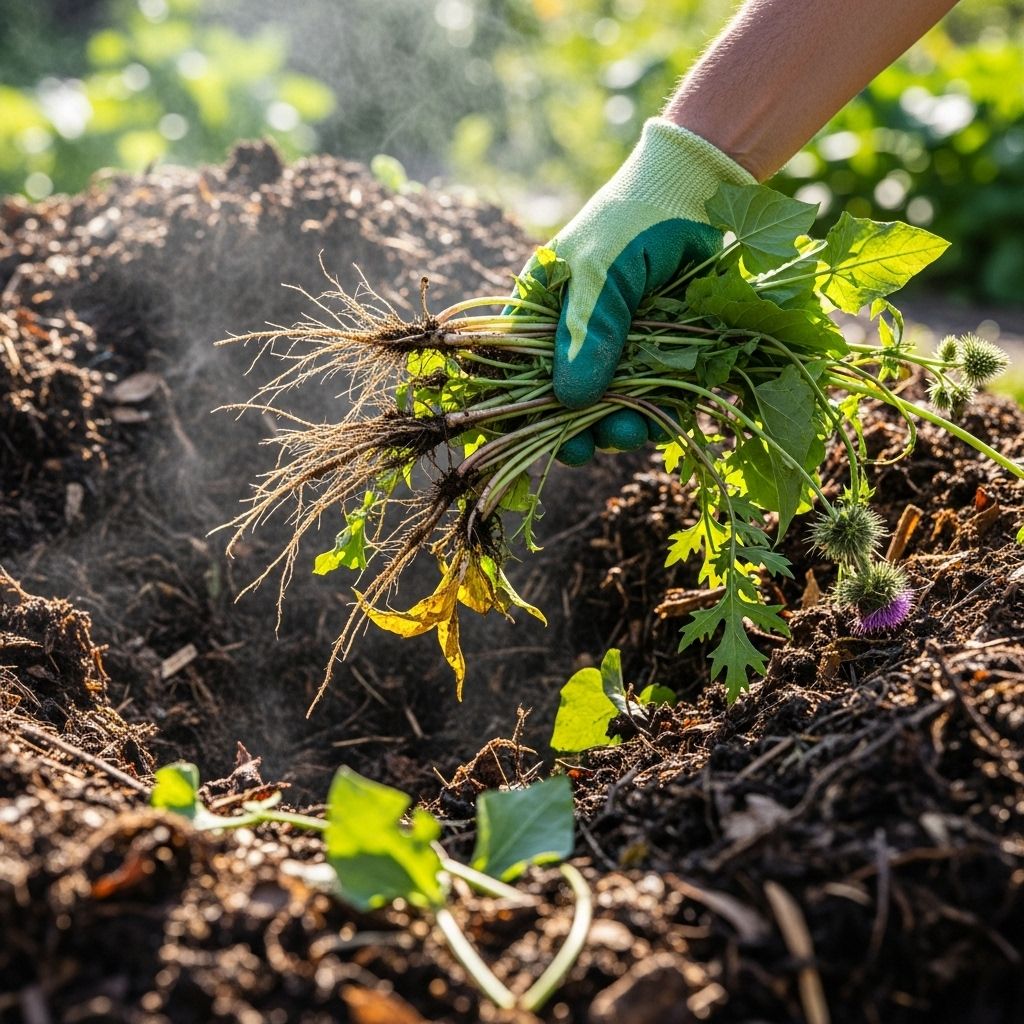Compost Weeds Safely: 5 Foolproof Methods to Avoid Regrowth
Heat and fermentation kill stubborn roots, turning garden intruders into rich, organic soil.

5 Foolproof Ways to Compost Weeds Without Spreading Them
Composting weeds is often met with concern by gardeners who worry about inadvertently spreading these persistent plants and their seeds. But with the right knowledge and techniques, you can turn even the most dreaded garden invaders into valuable organic matter that nourishes your soil. This comprehensive guide explores the science, best practices, and step-by-step methods for safely composting weeds and keeping your garden healthy.
Should You Compost Weeds?
Most weeds are loaded with nutrients that your soil can benefit from. Unlike yard waste that has been treated with pesticides or herbicides, weeds (pulled before they go to seed) can be a source of free, natural fertilizer when managed correctly. However, the risk lies in allowing bits of root or viable seeds to survive and regenerate — which is why proper technique matters when composting weeds.
- Why compost weeds? They add rich plant matter to your compost, boosting nitrogen and other minerals.
- Risks involved: Spreading living roots or seeds through unfinished or cold compost.
- When is it safe? With effective weed-destroying composting methods that reliably kill roots and seeds.
Best Practices for Composting Weeds
To make weed composting safe and effective, always follow good composting fundamentals:
- Do not compost: Weeds that have gone to seed unless you’re using a proven weed- and seed-killing method.
- Chop and shred: Break weeds into small pieces to ensure rapid decomposition and easier mixing.
- Mix evenly: Spread weeds throughout the pile to avoid clumps where seeds or roots might survive.
- Monitor moisture: Keep your compost moist but not soggy for optimal microbial action.
Weeds to Avoid in Your Compost
Some types of weeds and yard waste require caution or outright exclusion from your compost pile:
- Weeds treated with herbicides or pesticides.
- Invaders with persistent roots or tubers: Examples like bindweed, nutgrass, and Canada thistle can regrow from tiny pieces unless completely destroyed.
- Seed heads: If weeds have fully matured and set seed, their seeds may survive regular composting unless special measures are taken.
- Disease-prone plants: Avoid composting weeds (or any plants) with obvious fungal, bacterial, or viral infections to prevent spreading pathogens.
5 Proven Methods for Composting Weeds Safely
Here are five expert-endorsed ways to compost weeds, each targeting root and seed destruction so you can use weed matter with confidence.
1. Hot Composting: The Classic Weed-Killer
Hot composting involves carefully balancing greens (nitrogen-rich weeds, kitchen scraps) and browns (carbon-rich straw, leaves) to generate enough microbial heat for effective decomposition and sterilization of weed seeds and roots.
- How it works: A properly managed pile regularly reaches 130–150°F (54–66°C) for several days to a week, which is sufficient to kill most seeds and roots.
- Process steps:
- Build a pile at least 3’x3’x3′ for good heat retention.
- Layer weeds between browns and greens.
- Moisten and aerate to encourage microbial action.
- Turn the pile every few days so seeds and roots on the periphery are rotated into the hot center.
- Monitor the core temperature—compost thermometers help ensure you reach and maintain the weed-killing range.
- Limitations: Seeds or roots that remain on the cool edges or do not get mixed in properly may survive, so turning and temperature are key.
Table: Weed Seed Destruction Temperatures
| Target Temperature | Duration Needed | Result |
|---|---|---|
| 131°F (55°C) | at least 3 consecutive days | Most seeds and roots killed |
| 145°F (63°C) | 1-2 days | Highly effective, even for tough seeds |
2. Solarization: Harnessing Sun Power
Solarization is a low-tech but powerful technique, especially in hot climates. By using the sun’s heat, you can sterilize weed batches before adding them to the main compost pile.
- How to do it:
- Spread weeds in a thin layer inside a clear plastic bag or under a clear tarp.
- Seal and leave in direct sun for 2–4 weeks, ensuring temperatures inside exceed 140°F (60°C).
- Once the material is brown, crispy, and fully desiccated, add it safely to your compost pile.
- Benefits: Even stubborn roots and seeds can be reliably killed.
- Tips: Turn or shake the contents occasionally to ensure all layers are evenly heated.
3. Make Weed “Tea” or Liquid Fertilizer
If you want to put weed nutrients to use but worry about seeds, a liquid extraction method is fast, simple, and virtually risk-free.
- Process:
- Place weeds in a large bucket and cover with water.
- Cover loosely, then let the mixture steep for 2–3 weeks, stirring occasionally.
- Once decomposed and smelling strong, strain out the solids (which can be solarized and then composted, or discarded if you wish).
- Dilute the remaining solution 1:10 with water; pour around plants as a nutrient feeder, avoiding foliage to prevent burning.
- Advantages: Residual seeds and roots never return to garden beds, as only liquid nutrients are reused.
4. Drying Out: Baking Weeds to Death
Drying weeds until they are completely brown and brittle is a low-tech, slow, but effective approach—especially practical for small amounts or persistent perennial weeds.
- How to dry:
- Spread uprooted weeds (roots and all) on a hard, sunlit surface—concrete driveways work well.
- Allow the material to dry until completely crisp and lifeless, usually 1–2 weeks without rain.
- Crush the dried material; add to your compost as a valuable brown (carbon source).
- Best for: Thick-rooted weeds and those harvested before seed maturation.
- Warning: Do not compost even dried material if seed heads look viable or mature; use another method instead.
5. Bokashi Composter: Fermenting to Kill Weeds
Bokashi composting is an anaerobic fermentation method that can effectively process weed material, including seeds and roots, by fostering an acidic, microbe-rich environment.
- How it works:
- Add pulled weed roots and seeds to a bokashi bucket.
- Sprinkle bokashi bran (inoculated with special microbes) over each 1-inch layer of weeds.
- Repeat layers, compact down, and seal tightly.
- Let the contents ferment for 2–4 weeks, draining liquid every 2–3 days.
- After fermentation, bury the contents in soil or add to an active compost pile to complete decomposition.
- Benefits: Bokashi fermentation kills weed seeds via acidity and microbial action, preventing regrowth.
- Tips: Compact weeds well; you’ll fit more in each bucket than you expect.
Frequently Asked Questions (FAQs) about Composting Weeds
Q1: Can I compost weeds that have seeds on them?
You should only compost weeds with seeds if you use a method that heats the compost to at least 130°F (54°C) for multiple days or uses techniques proven to kill seeds, like hot composting, solarization, or bokashi composting. Regular compost piles often do not reach these temperatures, so weed seeds may survive and regrow if added untreated.
Q2: What about weeds with thick roots or rhizomes?
Persistent weeds with strong roots or rhizomes (e.g., Bermuda grass, bindweed) need extra caution. Bake them in the sun, use a hot compost pile, or place them in a sealed black bag in the sun until fully dried or decomposed before composting.
Q3: Can herbicide-treated weeds go in the compost?
Never compost weeds or grass clippings treated with herbicides, pesticides, or fungicides. These chemicals can persist in compost and damage garden plants. Instead, dispose of them through municipal yard waste programs and wait at least one year before reconsidering their use.
Q4: Can I use composted weed matter directly around edible crops?
Compost weed matter only after confirming full decomposition and seed/root destruction. When in doubt, use cured compost around ornamental beds or test on non-edible areas before broad edible garden application.
Q5: What should I do if weeds sprout in my compost pile?
This often happens with cold compost piles and is not unusual. Turn the pile to bury any sprouts; the lack of light and regular mixing will eventually kill them. To prevent recurrence, use a hot compost technique and monitor pile temperatures.
Additional Tips for Effective Weed Composting
- Prioritize prevention: Pull weeds before seeds form for the simplest composting.
- Chop up: Use garden shears to break up large weeds—smaller pieces decompose quickly.
- Avoid composting diseased weeds: Disease pathogens may survive typical composting temperatures; discard these in the trash.
- Don’t let fear keep you from composting: Most weeds are an excellent compost resource when approached skillfully and with due care.
- Monitor your finished compost: When ready to use, inspect for any suspicious roots or seeds and remove them before applying to garden beds.
Quick Reference: Composting Weed Types & Methods
| Weed Type | Safe Composting Methods | Caution Needed? |
|---|---|---|
| Young, seed-free weeds | Any method, especially hot/regular compost | Low |
| Weeds with seeds | Hot compost (130°F+), solarization, bokashi | Yes |
| Roots/rhizomes | Solarization, hot compost turned often, full drying | High |
| Pesticide/herbicide residue | Do NOT compost | Very High |
Empower Your Garden: Compost Weeds with Confidence
Weeds are an inevitable part of gardening, but they don’t have to be a waste product. With careful attention to timing, method, and safety, you can convert all the unwanted growth in your garden into dark, rich compost that fuels next season’s crops. Whether you go high-tech with bokashi or rely on the reliable heat of a well-managed pile, follow these techniques to make weeds work for you, not against you. Transform concern into confidence, and let your compost bin become your best line of defense—and offense—in the endless cycle of garden growth and renewal.
References
Read full bio of Anjali Sayee












